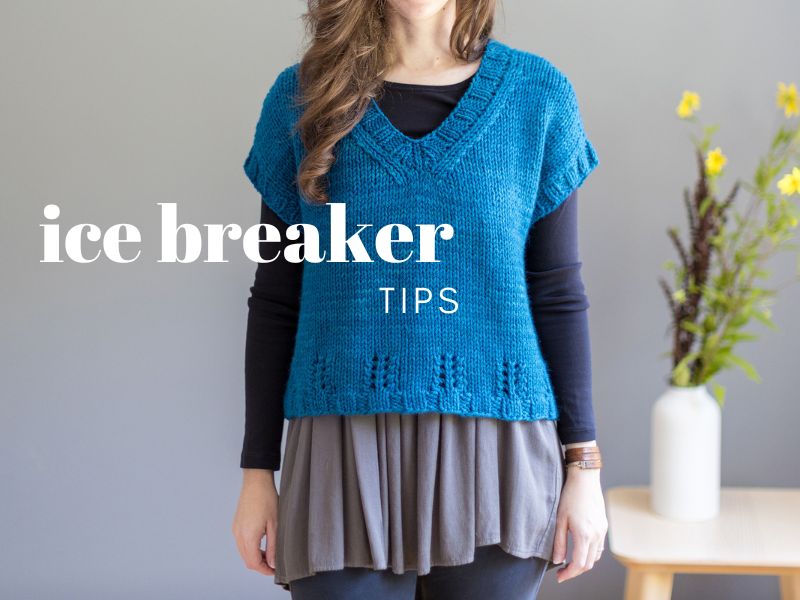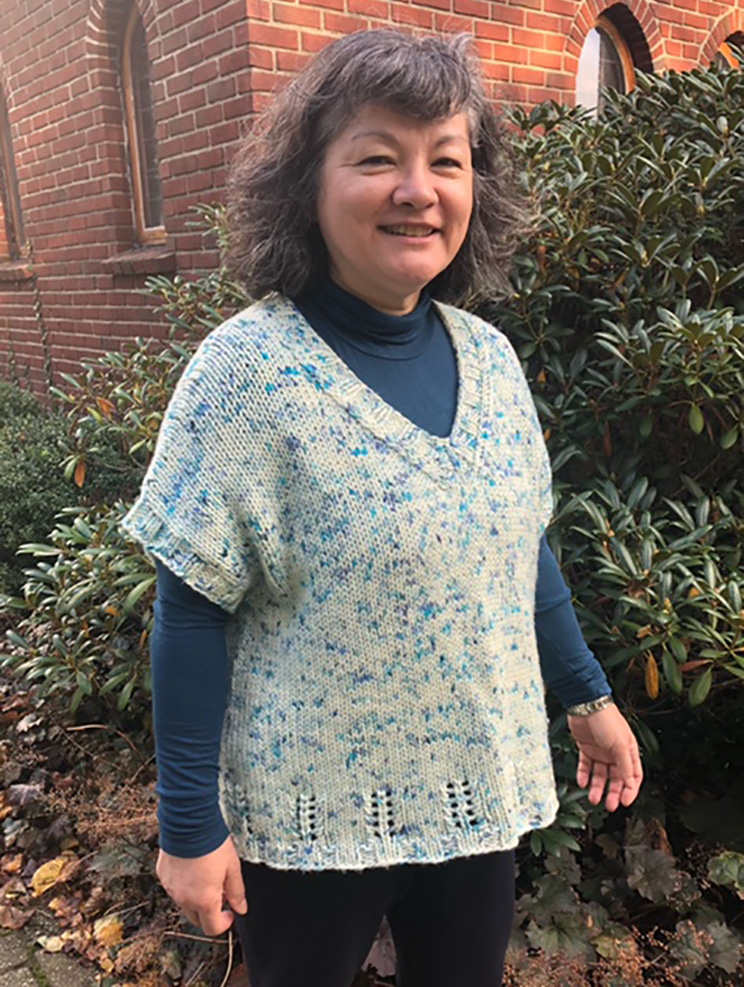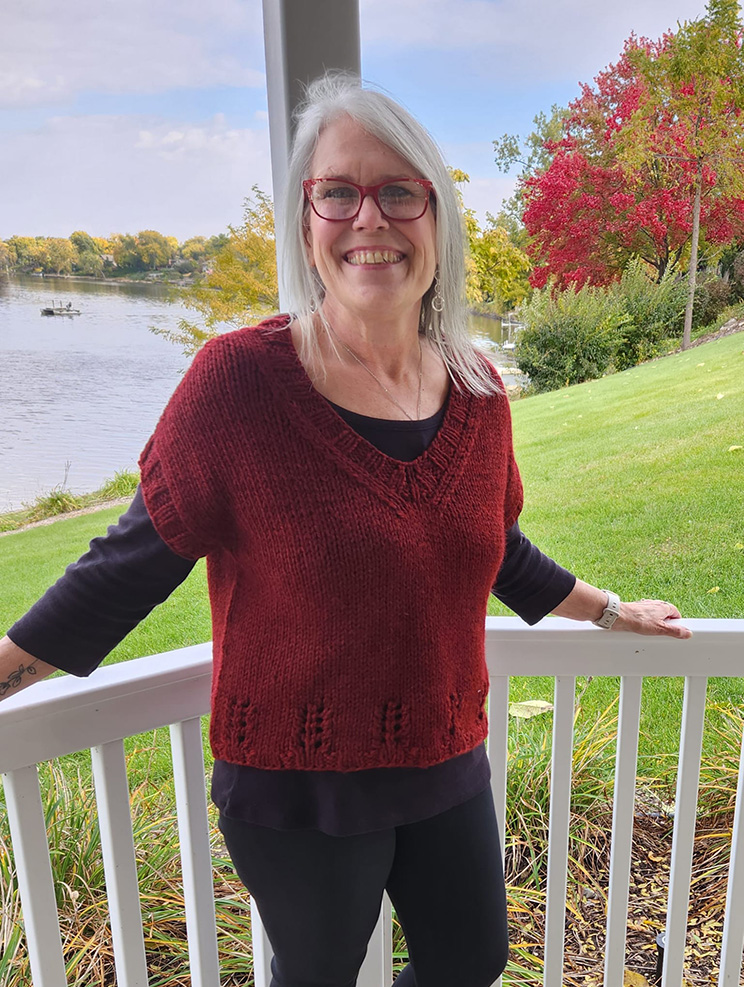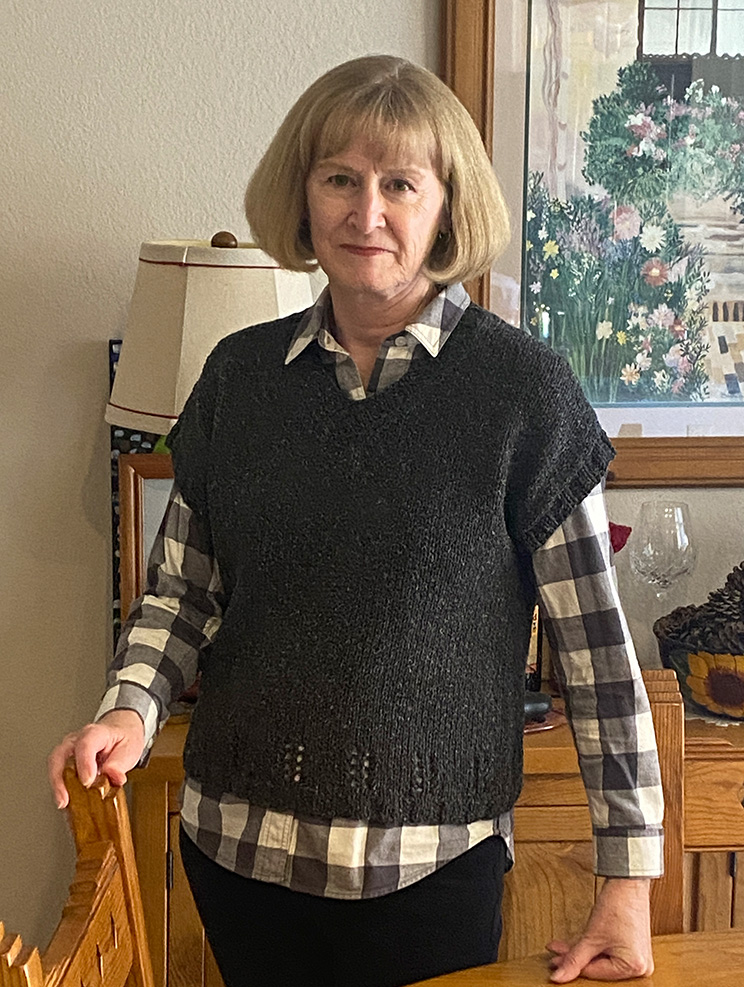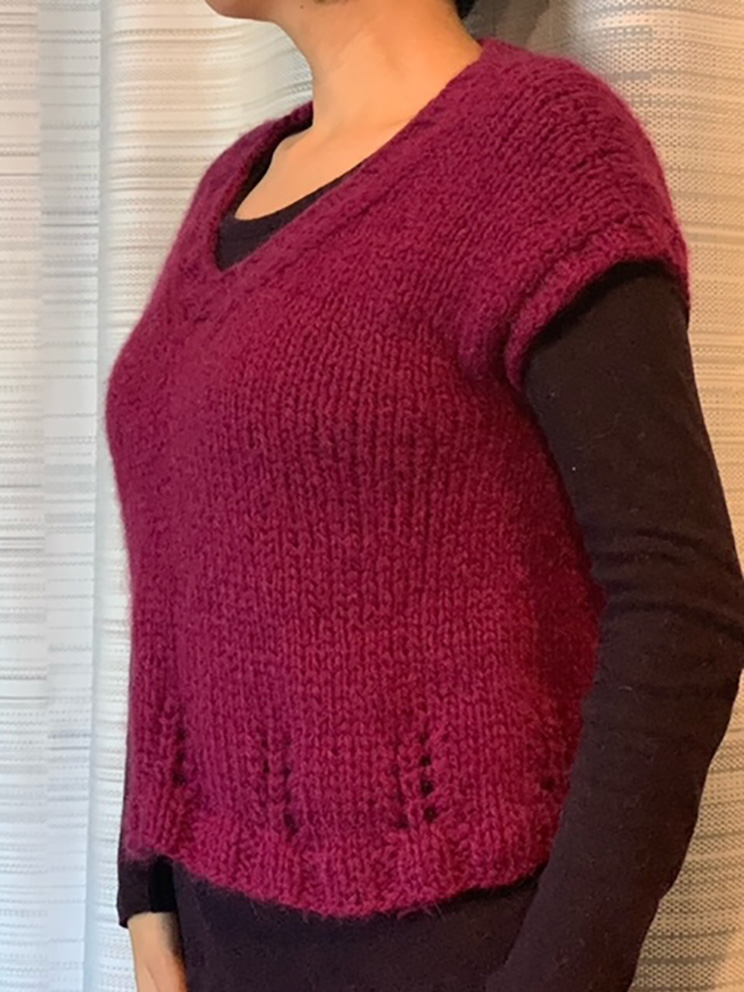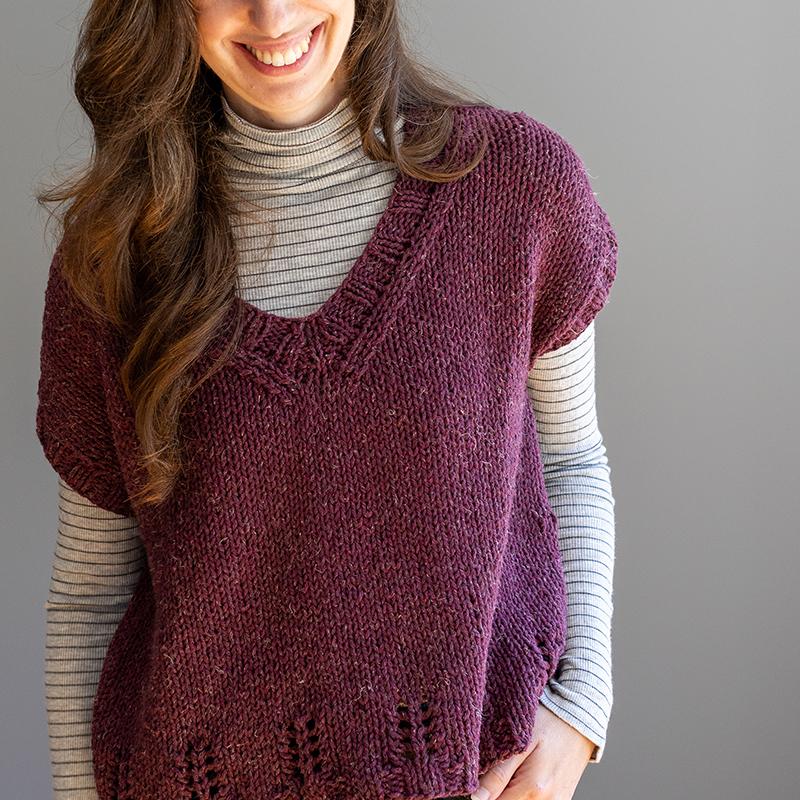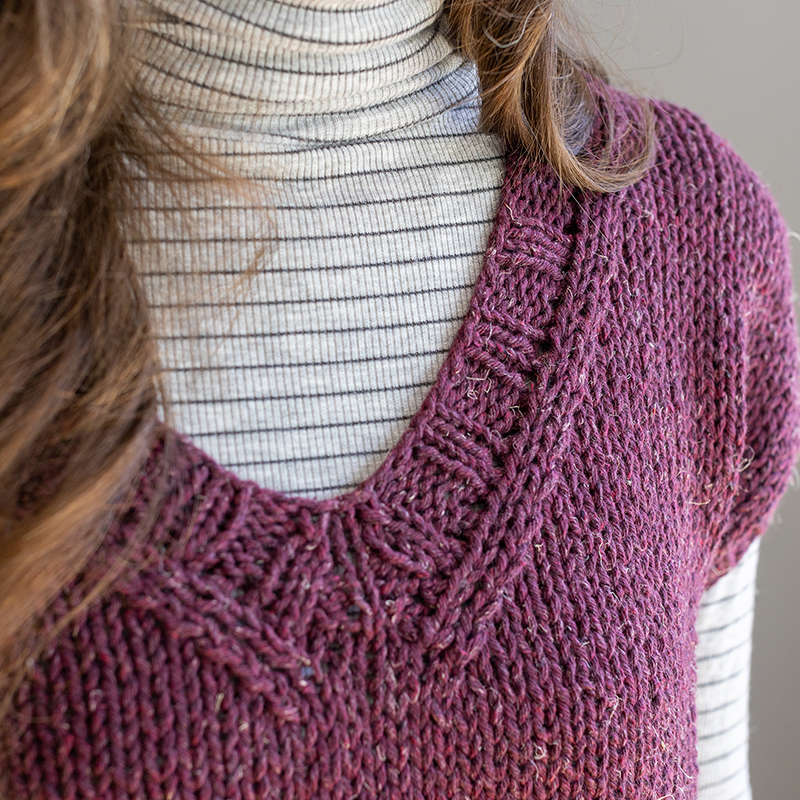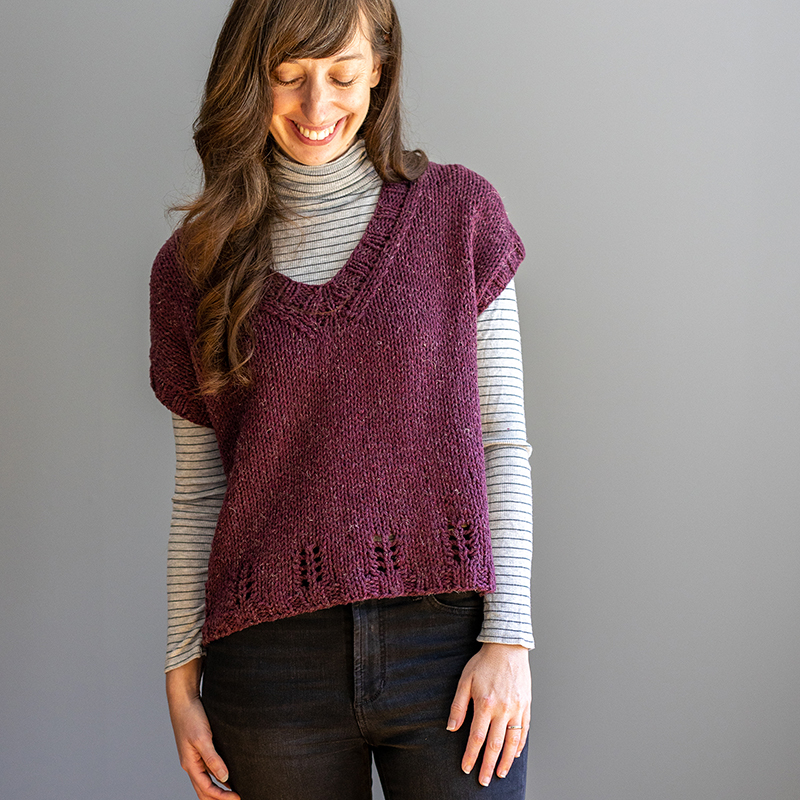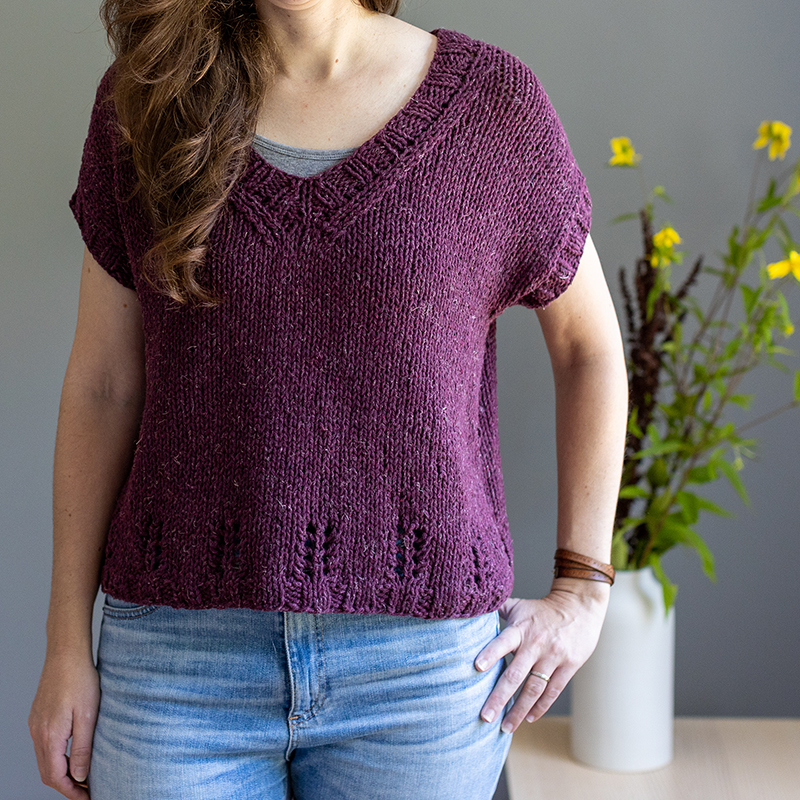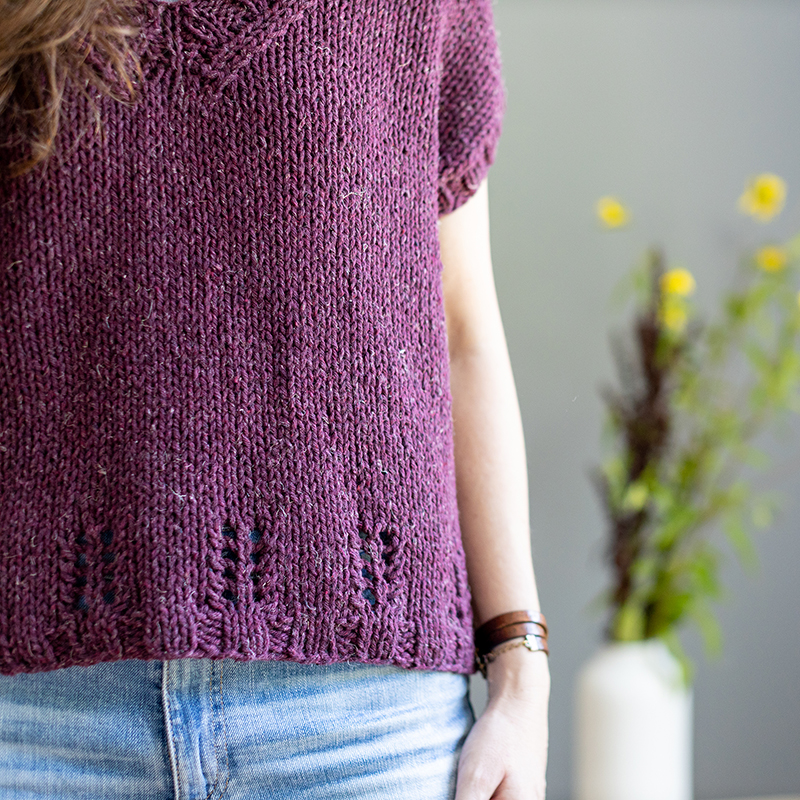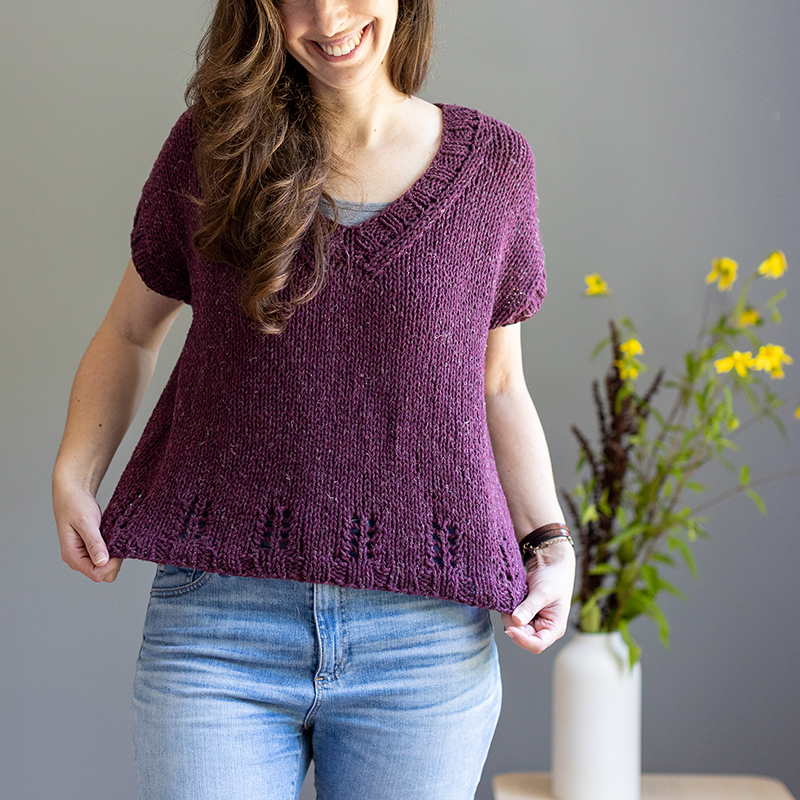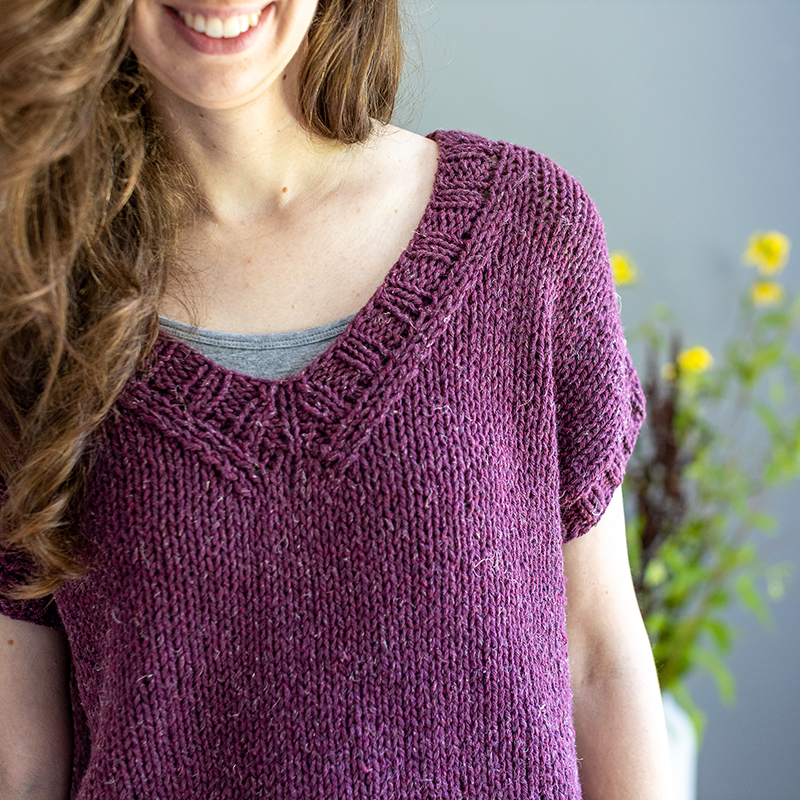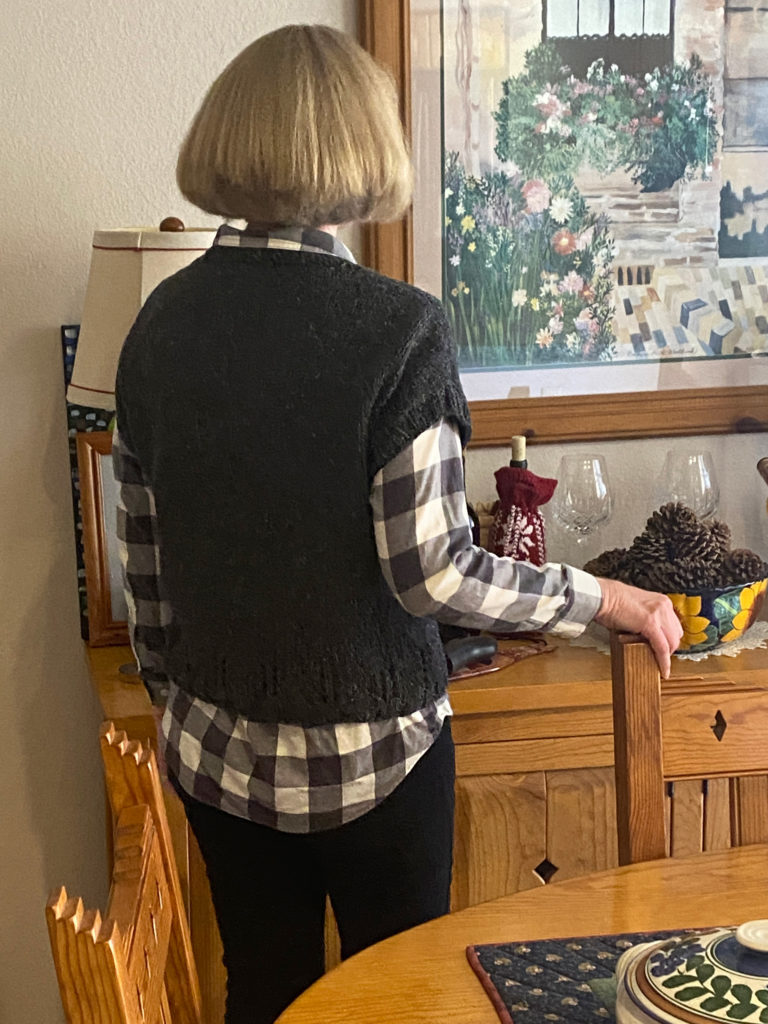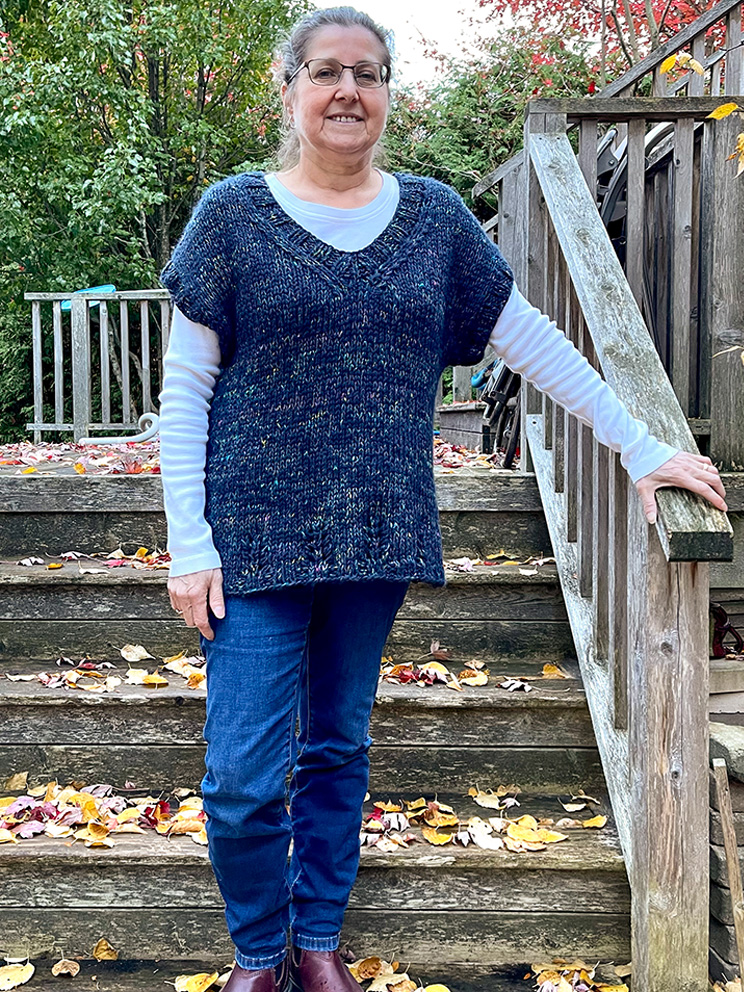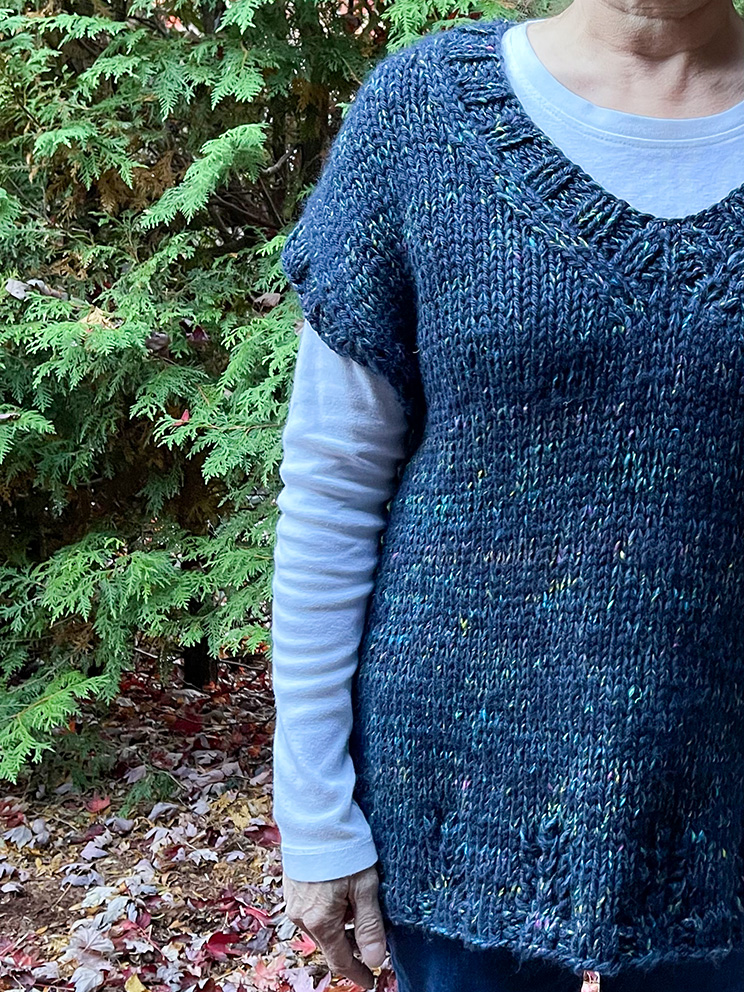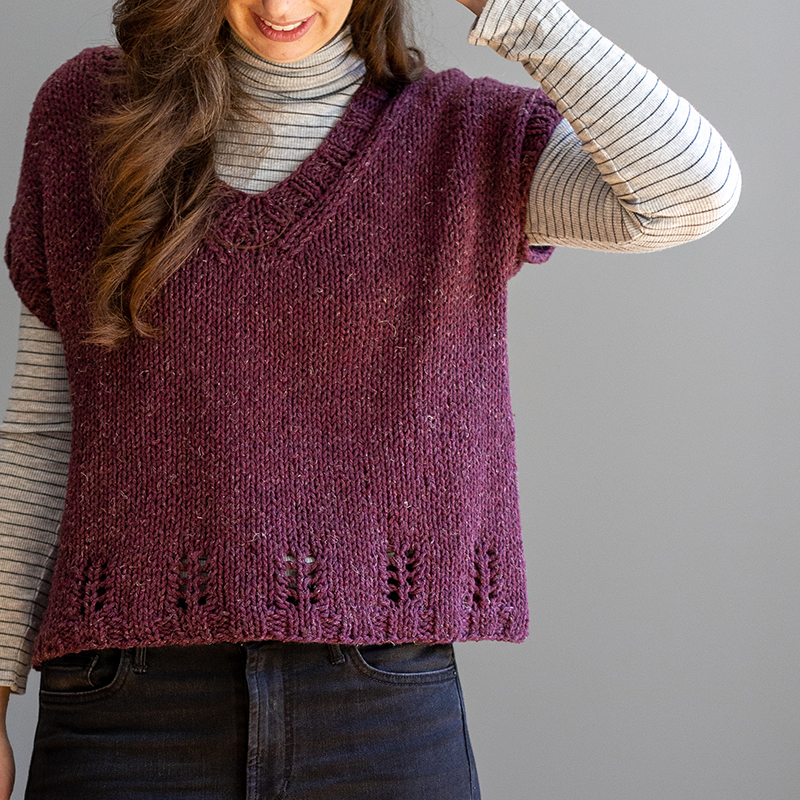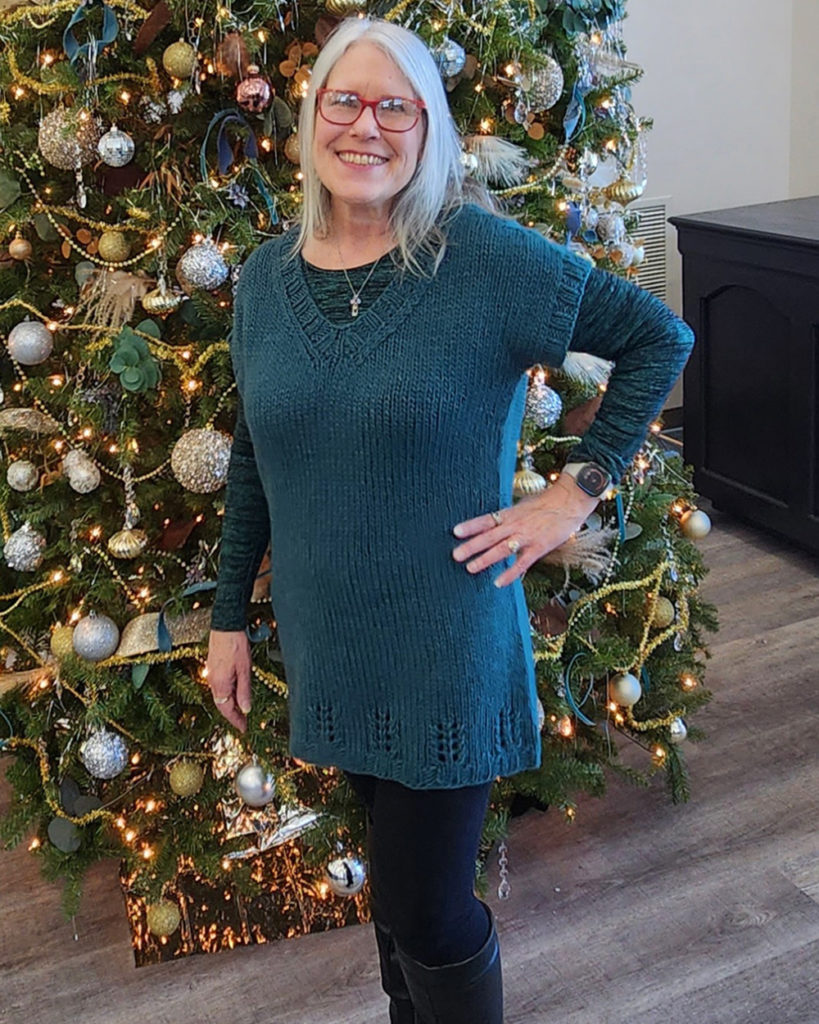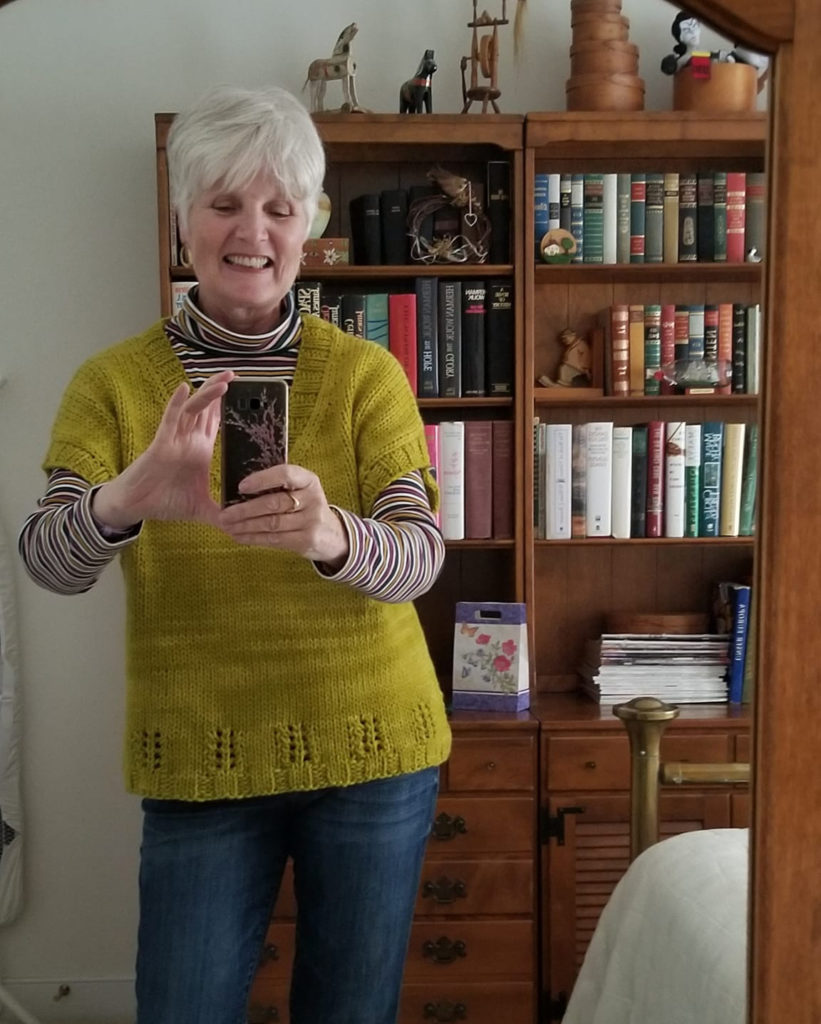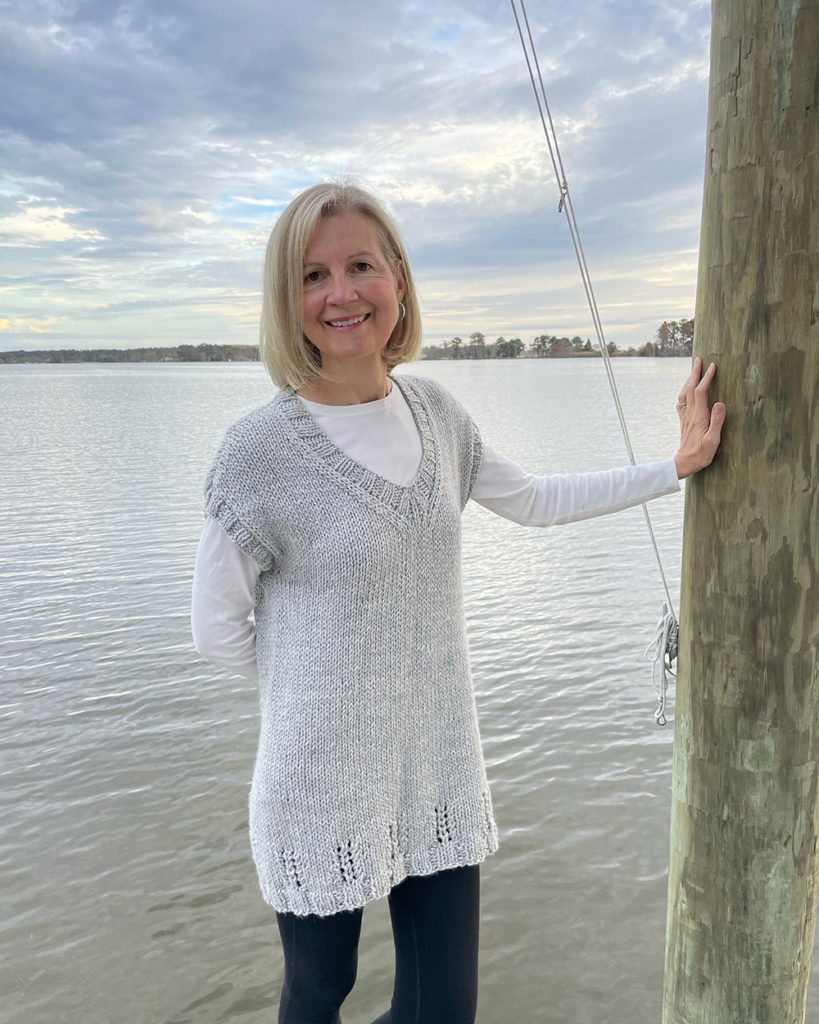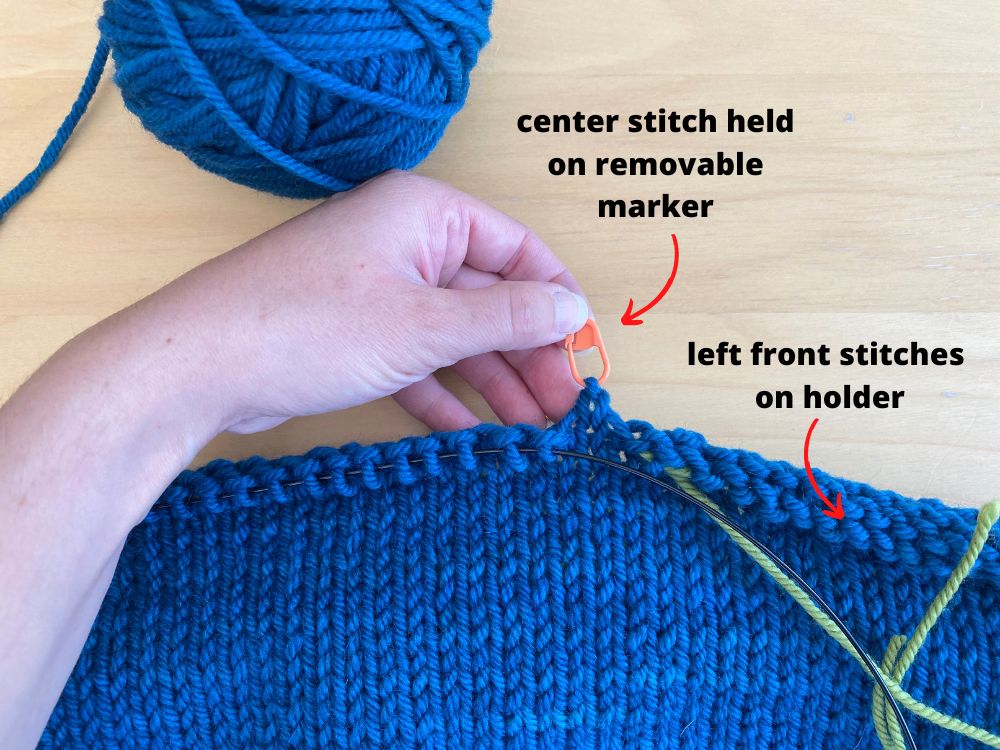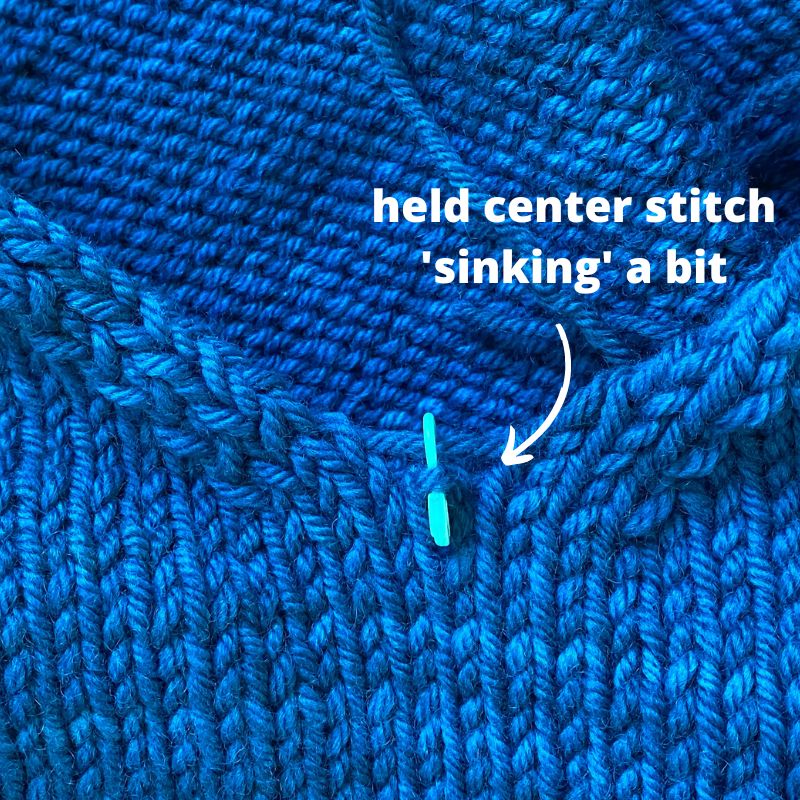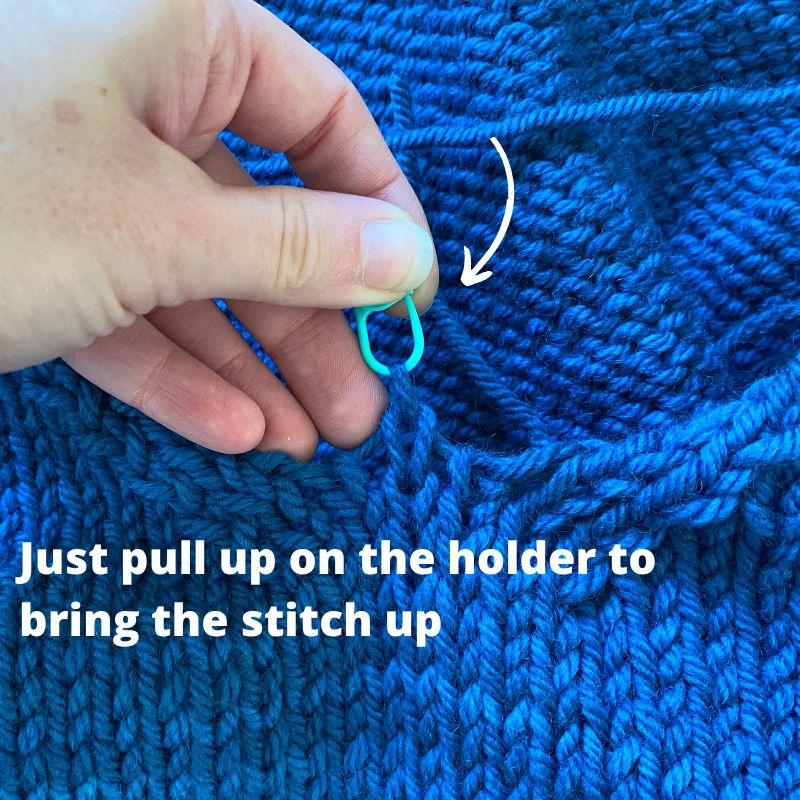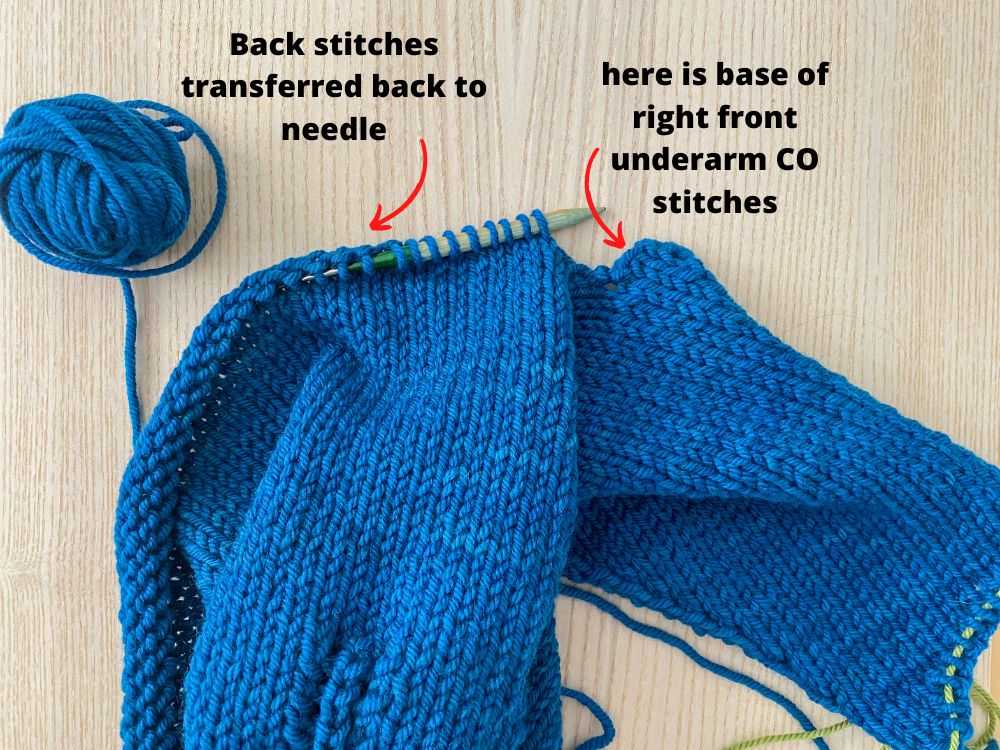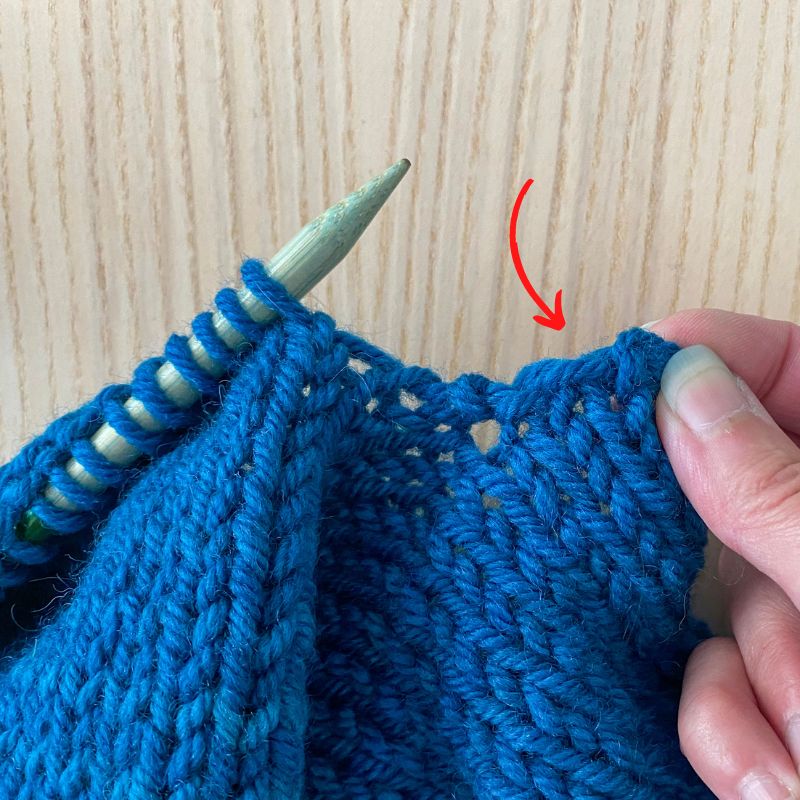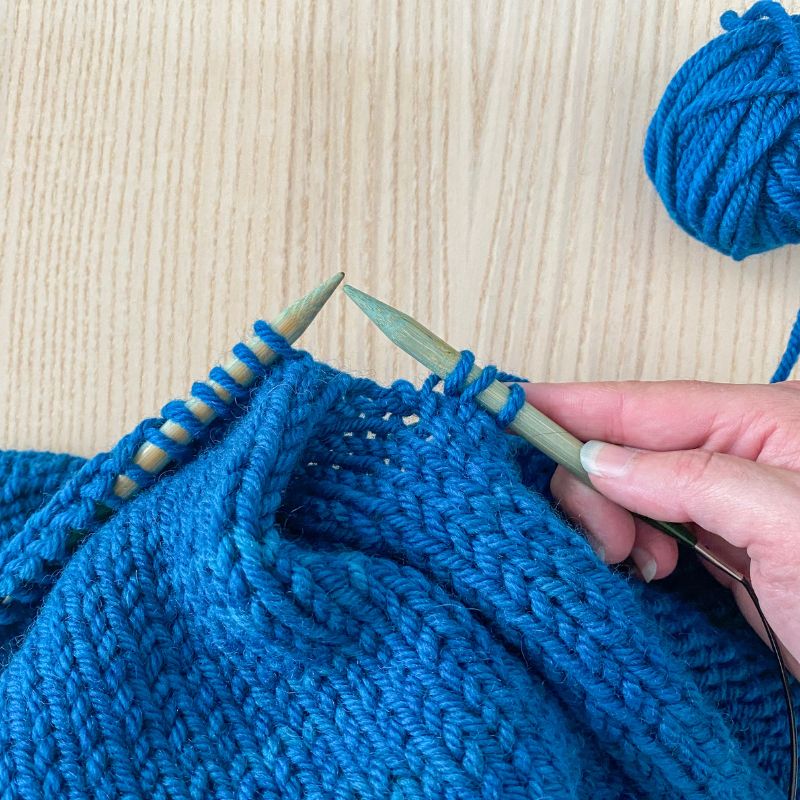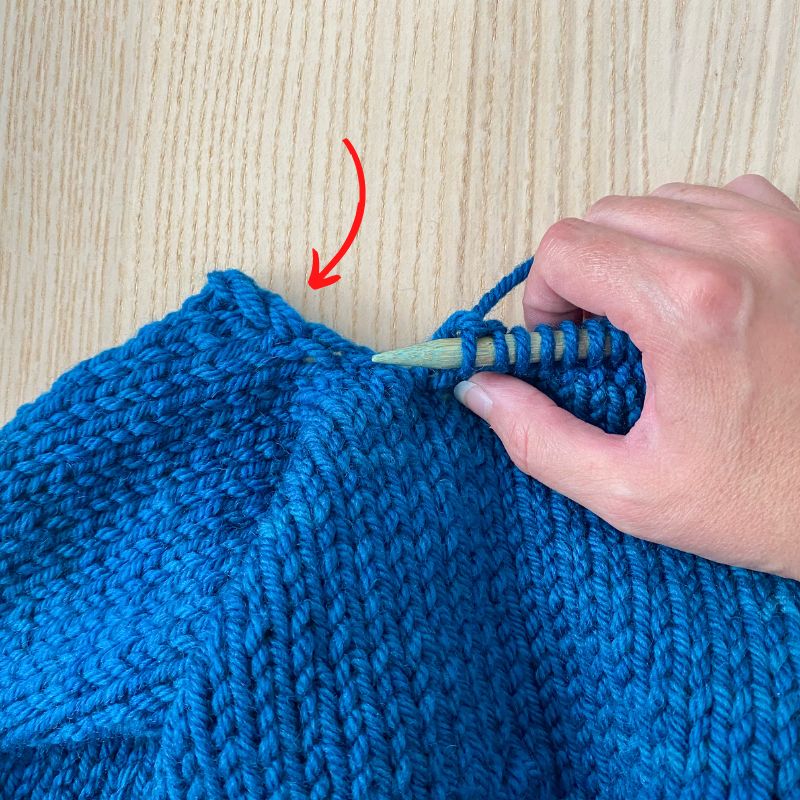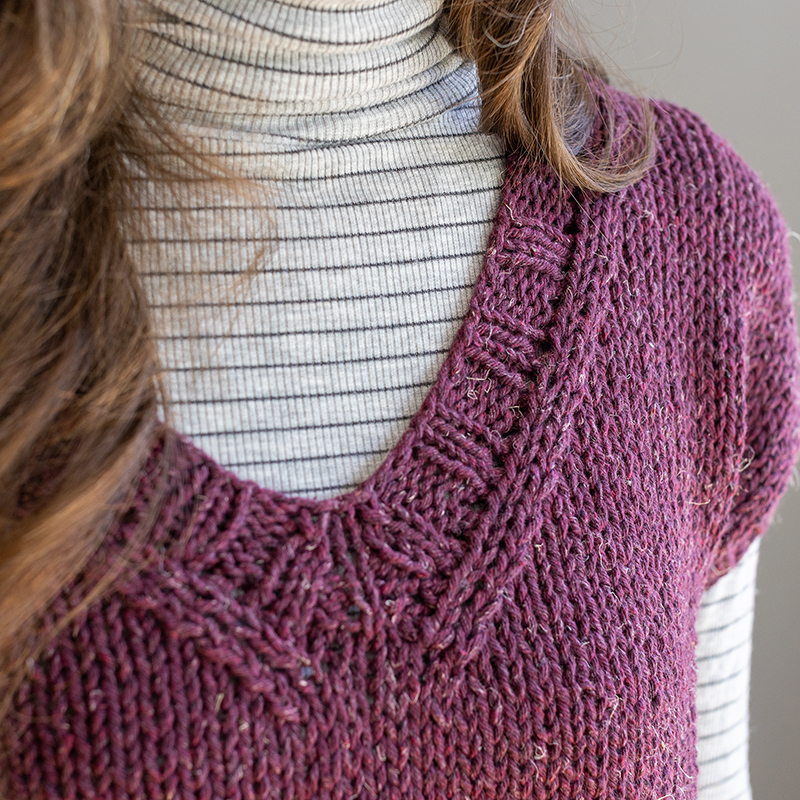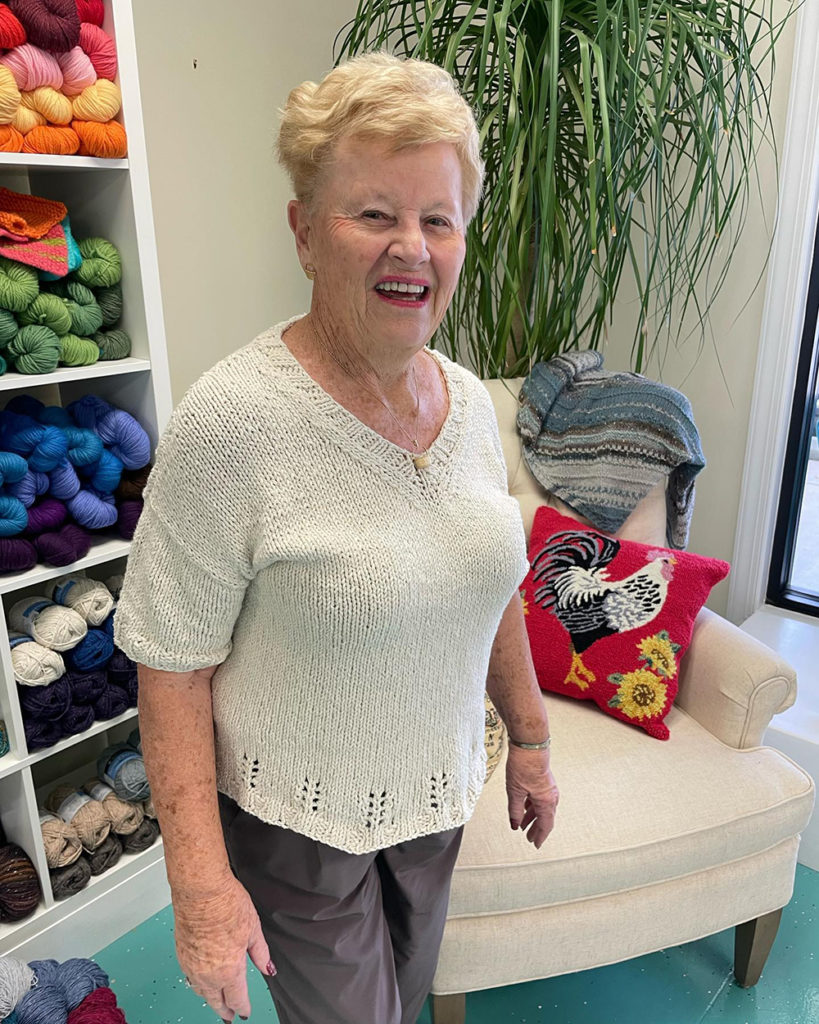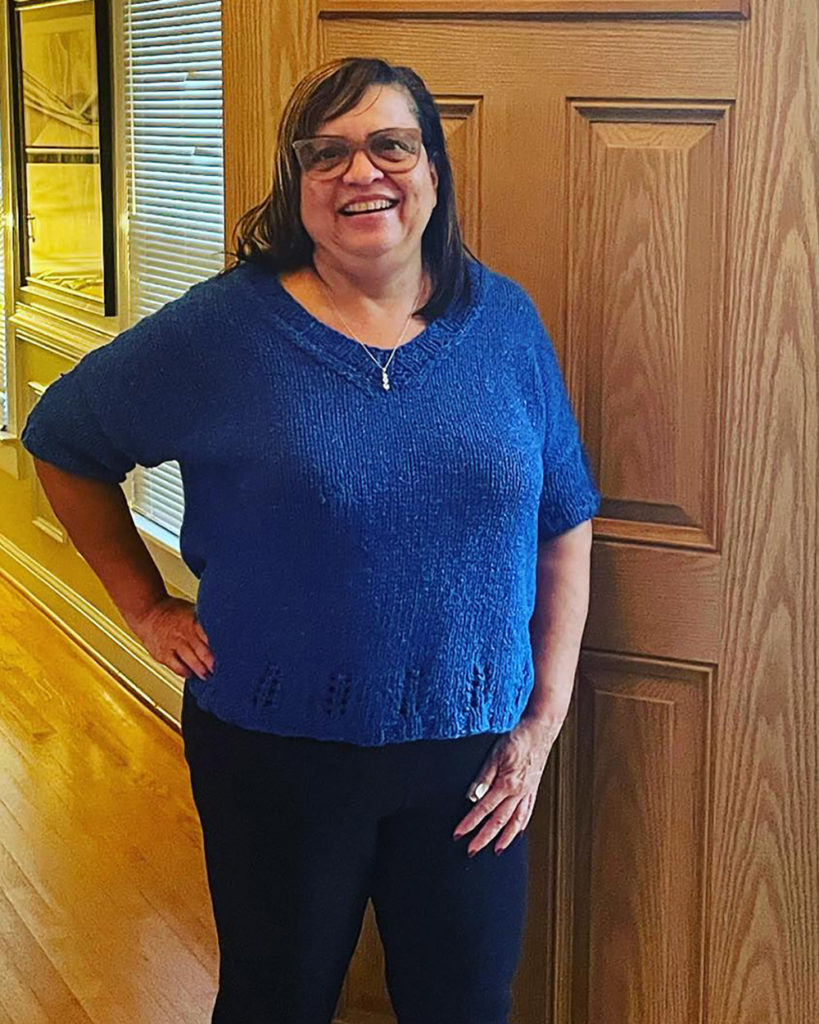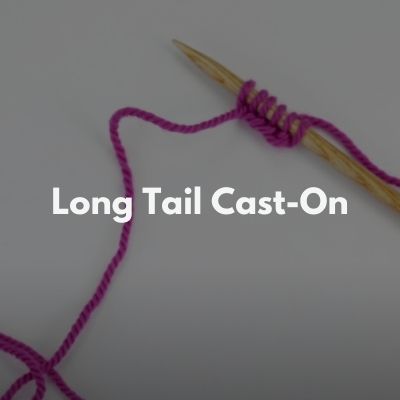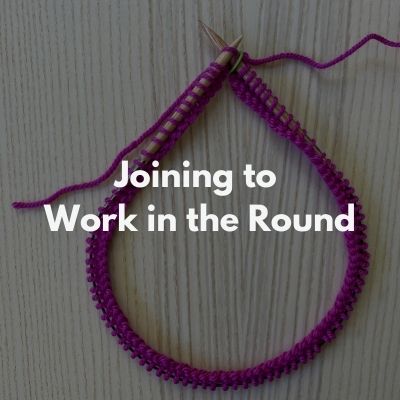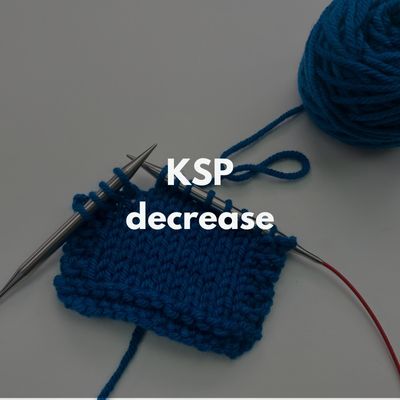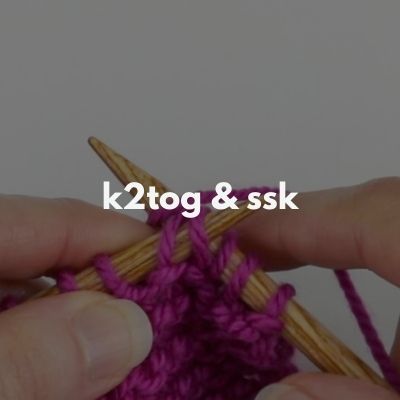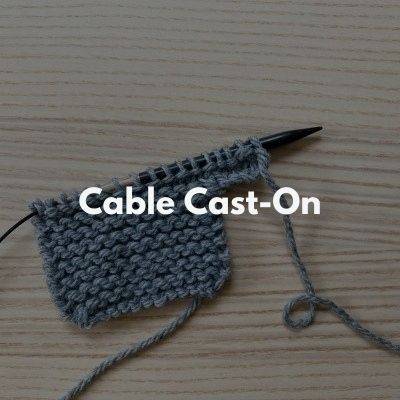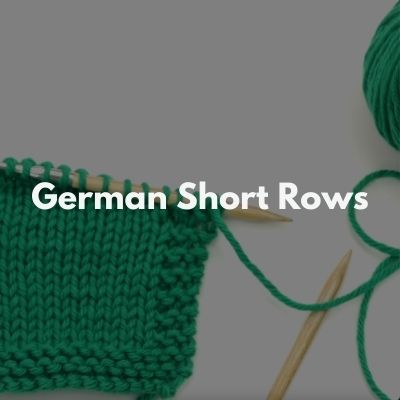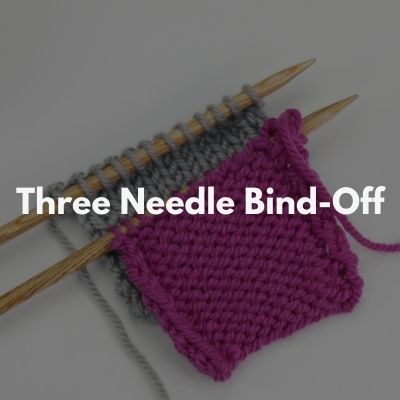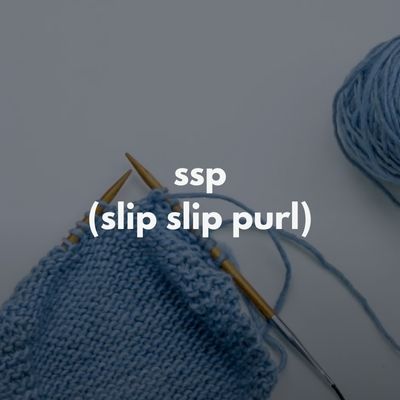Ice Breaker Tips
On this page you’ll find tips and tutorials for all the techniques used in my Ice Breaker top! I review the following topics on this page:
- Picking a size
- Yarn options
- Gauge swatching in the round
- Adjusting for different gauge
- Adjust for A-line shaping
- Eyelet stitch pattern tips
- Adjusting the length
- Adjusting the armhole depth
- Working the Front Divide
- Working back at the underarm
- Pick-up and knit (for v-neck & armhole ribbing)
- Making sleeves longer
- The following knitting techniques:
- Long-tail cast-on
- Joining to work in the round
- ksp decrease
- ssk decrease
- YO increase
- Cable cast-on
- German short rows (working the “DS”)
- Three needle bind-off
- ssp decrease
Picking a Size
There are 10 different sizes to pick from when knitting your own Ice Breaker. Because of the drop-shoulder construction, I recommend picking a size that is approximately 5-10″ larger than your actual bust measurement. For example, if your actual bust is around 36″, then I would suggest picking a size whose finished circumference is between 41-46″ (so either size 2 or 3). Of course you could choose a size with less or more ease than that range depending on the look you are going for (less than 5″ of ease will give you a more fitted look and more than 10″ of ease will give you a more oversized look). Check out the photos below to see the different ease amounts from my test knitters!
And to learn more about “positive ease”, especially as it relates to drop-shoulder constructions, read my tutorial here.
As with so many things with knitting, picking a size is totally up to you and your particular body and style, so although I suggest this amount of positive ease, you can feel free to pick outside of this range! The only thing to consider though is that if you pick a size that has less than 5″ of positive ease that you should add 1″ or so in length to your armhole depth (I talk about this a bit more in the tutorial linked above). For info on where you should add these extra rows to your armhole depth, keep reading below or click here to jump down to that section.
Preview Knitter Examples:
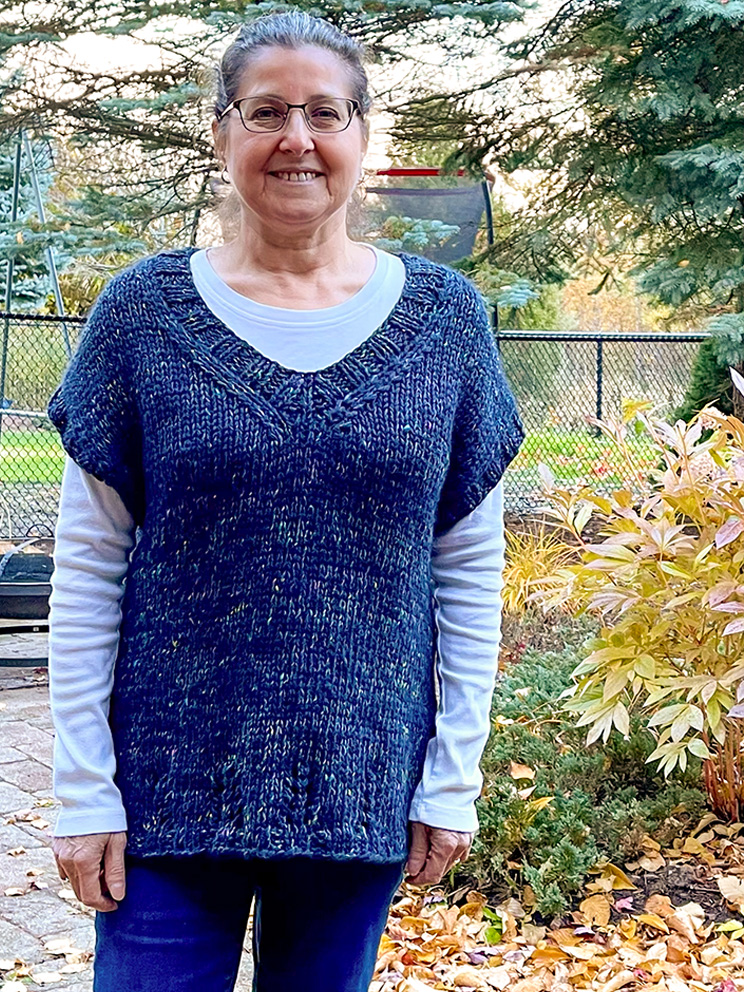
Check out more preview knitter photo inspiration here in my blog post! (link coming soon).
Yarn Options
Ice Breaker calls for bulky-weight yarn and I used the gorgeous Manos del Uruguay Cardo – a 100% wool yarn with subtle semi-solid colorways. Knitting with this yarn was a joy! If you are looking for a cozy, warm layering piece then I highly recommend this yarn. I’d say it’s the type of bulky yarn that falls in-between a traditional bulky and a super-bulky (so it’s a heavier bulky-weight).
Due to the sturdiness and warmth of 100% wool, I understand that this yarn may not be for everyone (since you may live in a warmer climate!). If you need a non-wool option, I also knit up a version in Berroco Remix Chunky. This yarn is a nylon/cotton/acrylic/silk/linen blend and knits up a little looser than Cardo (since it’s not quite as bulky), which gives it a bit more drape – check out my slideshow of images below:
Other yarns I’ve swatched with or that my preview knitters used to make theirs are listed below. Note: you can also consider double-stranding worsted-weight yarn together!
- Tahki Yarn’s Superwash Merino Bulky
- Malabrigo Chunky
- Cascade 220 Grande
- Kraemer Yarns Perfection Chunky
- Brooklyn Tweed Quarry
Gauge Swatching in the Round
The pattern gauge of Ice Breaker is 11.5 sts & 17 rnds = 4”/10 cm in Stockinette stitch in the rnd after blocking. Because the body is knit in the round (and this determines your overall circumference), it’s important to gauge swatch in the round. If you are new to this, check out my tutorial here.
Note: it’s more important to focus on achieving stitch gauge, so don’t worry if you can’t get the exact row gauge. You can adjust your body length or armhole depth as needed to account for any row gauge discrepancy.
Adjusting for different gauge
Let’s say that you do your swatching but can’t get gauge, or you just don’t like the look of the fabric at the pattern gauge. Here is one option to consider: you can knit at a tighter gauge but knit a larger size. Here’s an example from one of my preview knitters, Susan.
She used Remix Chunky but didn’t like the looser fabric at the pattern gauge. So instead she swatched on a US 10 and got a gauge of 14 sts & 20 rows = 4″. She had wanted to knit the size 2 or 3 which had finished measurements of either 41.75″ and 45.25″. But at her tighter gauge, if she followed the instructions for size 5, she would end up with a finished circumference of approx. 42.75″ which would be perfect. So how do you do this calculation yourself? Simply take the cast-on number and divide it by your per inch stitch gauge to get what the finished measurement of that size would be for your gauge. Do this for a bunch of sizes and you can then decide which size is closest to what you are looking for.
Adjust for A-line Shaping
One of my preview knitters, Lisa, adjusted the pattern a bit to be A-line shaped and so I thought I would add some details about that here! She is wearing with less positive ease at the bust than I suggest (about 3″ of positive ease), but it works for her because she cast-on for 1 size larger (than the size she wanted to fit at her bust) and then worked decreases in the body until she got to the stitch count of the 1 size smaller. This way the top didn’t have a fitted look in the body, but she got the fit she wanted for the top area.
If you would like to do something similar for your Ice Breaker, you can view her notes on her Ravelry page here.
Eyelet Stitch Pattern Tips
Featured right above the ribbed hem is an eyelet stitch pattern. Here are some tips you might find helpful when working this section:
- The eyelet stitch is created by working a “ksp” right-leaning decrease (tutorial here), then a YO (tutorial here), then a k1, YO, and then a “ssk” left-leaning decrease (tutorial here).
- In such a bulky-yarn, I found the ksp decrease to look nicer than the more common k2tog, but if you find the ksp to be too difficult to work, feel free to replace it with a k2tog (the difference is subtle).
Adjusting the Length
As written, the underarm to hem length of Ice Breaker is 10″. It’s good to keep in mind though the overall length of the garment – which, depending on your size, ranges from 20.25-22.75″. To decide whether or not you want to add length, take a take measure and starting at the top of your shoulder (where it meets the neck), measure downwards. If, depending on your chosen size, the garment length is not where you would ideally like it, just decide how many extra inches you would like and add that to the Body section (before the Underarm Divide).
Here are some examples of added length in Ice Breaker:
Adjusting the Armhole Depth
Due to the v-neck shaping, if you want to lengthen your armhole depth, the easiest spot to do this is by adding rows right before the “Front Divide” section (so in the “Front” section). So if you look at the schematic and know you want to add an additional 1″ to the armhole depth, then work 1″ worth of extra rows before you move on to the “Front Divide” section. Just make sure to keep count of the number of extra rows you add so that you can replicate this on the Back.
Working the “Front Divide”
The “Front Divide” section is where you separate the left and right front, and you’ll also put the front center stitch on a removable marker (you’ll understand why you do this to the center stitch later on, during the v-neck ribbing section).
In step 1 of this section you first work your front left side (note: “left” and “right” are from the perspective of wearing the garment), and then you’re instructed to put these stitches on a holder or scrap yarn. Then in step 2, you’re instructed to k1, and then place this 1 stitch on a removable marker. Then in step 3 you’ll work the front right side to the end. After this divide row is done, you’re work will look something like this:
Here’s a tip: sometimes the held center stitch may ‘sink’ a bit into the fabric. From time to time, just check on it and if needed, pull the marker up to bring the stitch up. Below are 2 pictures that demonstrate this:
Working the Back at the Underarm
After you’ve worked the Fronts, you’ll move on to the Back section where, in step 1, you’ll be instructed to pick up and knit into the bases of the Right Front Underarm CO stitches. Where are those exactly? My picture below may help to better illustrate things:
Here are some additional photos that help illustrate this first row:
For a video of how this technique works, check out my demonstration here. It was for my Azalea top, so it’s a different design (and you pick up and knit a different number of stitches), but the technique is the same as what you need to do in Ice Breaker.
One important note: After you have worked the above process, you will likely have a little hole on either side (image below). That is to be expected and can easily be cinched up when weaving in your ends later. Using my Azalea top again as our example, if you watch this clip I show you how I used the duplicate stitch to cinch things up at the underarms.
Pick-up and Knit Trim
Here are tips that will help you with picking up and knitting stitches for the trim areas (neckline & armhole).
V-Neck Trim
I walk you through exactly how I pick-up and knit these v-neckline stitches in the video below!
Armhole Trim:
If you would like a tutorial of how to pick up and knit around an armhole, check out my tutorial here. I use the magic loop technique (which you can also try if you don’t have a 16″ circular), but even if you aren’t magic-looping the technique I work will be similar. Due to the bulkiness of the yarn, you can choose to just pick-up and knit into 1 leg of each “v” stitch (similar to how I demonstrate along the vertical edge in the v-neck video above).
Making Sleeves Longer:
Want to make your Ice Breaker sleeves longer? It’s an easy adjustment. Below are a couple of photos of knitters who had done just that (courtesy of the yarn shop Coastal Purl!):
Here are some tips for making your sleeves longer:
- Follow the same pic-up and knit instructions as listed in the pattern for Armhole Edging, but use the same needle size as you had used for the body (not the smaller one).
- If you don’t want your sleeves to taper, simple knit every round until you are approx. 1″ or so away from your desired length. Then switch to the smaller needle and work the rib trim as specified in the pattern.
- If you do want a taper, you can work some decrease rows. How many will just depend on long you actually want to make your sleeves. In general, here is what I suggest:
- After picking-up stitches, work in Stockinette stitch in the round (so knitting every round) for approx. 1″.
- Work a decrease row as follows: k1, ssk, k to last 3 sts, k2tog k1 (2 sts decreased).
- Then continue in stockinette stitch in the round, repeating above decrease round every 1-2″ until you are approx. 1″ away from desired length. But keep an eye on your sleeve circumference and make sure it’s not getting too tight (it’s easy to try on at this point, so I recommend doing that). If you are happy with the fit but want more length, just continue working in St st and don’t work anymore decreases. If you just want elbow-length sleeves, you may just be fine with 1 or 2 decrease rounds.
- Then switch to the smaller needles and work the rib trim as specified in the pattern.
Knitting Techniques Used in the Pattern:
Below are links to different knitting techniques that are used in Ice Breaker.

